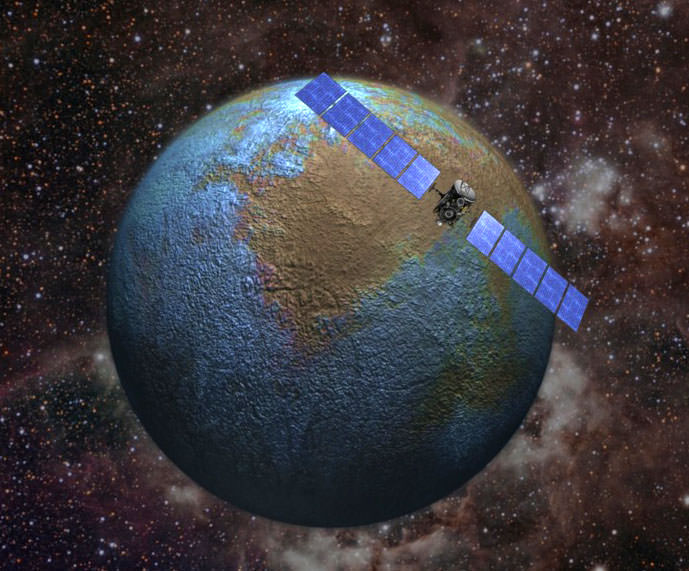Host: Fraser Cain (@fcain)
Special Guest: Bas Lansdorp, CEO of Mars One
Guests:
Morgan Rehnberg (cosmicchatter.org / @MorganRehnberg )
Brian Koberlein (@briankoberlein)
Alessondra Springmann (@sondy)
Dave Dickinson (@astroguyz / www.astroguyz.com)
Continue reading “Weekly Space Hangout – April 24, 2015: Bas Lansdorp, CEO of Mars One”
Weekly Space Hangout – April 17, 2015: Amy Shira Teitel and “Breaking the Chains of Gravity”
Host: Fraser Cain (@fcain)
Special Guest: Amy Shira Teitel (@astVintageSpace) discussing space history and her new book Breaking the Chains of Gravity
Guests:
Morgan Rehnberg (cosmicchatter.org / @MorganRehnberg )
This Week’s Stories:
Falcon 9 launch and (almost!) landing
NASA Invites ESA to Build Europa Piggyback Probe
Bouncing Philae Reveals Comet is Not Magnetised
Astronomers Watch Starbirth in Real Time
SpaceX Conducts Tanking Test on In-Flight Abort Falcon 9
Rosetta Team Completely Rethinking Comet Close Encounter Strategy
Apollo 13 Custom LEGO Minifigures Mark Mission’s 45th Anniversary
LEGO Launching Awesome Spaceport Shuttle Sets in August
New Horizons Closes in on Pluto
Work Platform to be Installed in the Vehicle Assembly Building at NASA’s Kennedy Space Center in Florida.
Watching the Sunsets of Mars Through Robot Eyes: Photos
NASA Invites ESA to Build Europa Piggyback Probe
ULA Plans to Introduce New Rocket One Piece at a Time
Two Mysterious Bright Spots on Dwarf Planet Ceres Are Not Alike
18 Image Montage Show Off Comet 67/P Activity
ULA’s Next Rocket To Be Named Vulcan
NASA Posts Huge Library of Space Sounds And You’re Free to Use Them
Explaining the Great 2011 Saturn Storm
Liquid Salt Water May Exist on Mars
Color Map Suggests a Once-Active Ceres
Diverse Destinations Considered for New Interplanetary Probe
Paul Allen Asserts Rights to “Vulcan” Trademark, Challenging Name of New Rocket
First New Horizons Color Picture of Pluto and Charon
NASA’s Spitzer Spots Planet Deep Within Our Galaxy
Icy Tendrils Reaching into Saturn Ring Traced to Their Source
First Signs of Self-Interacting Dark Matter?
Anomaly Delays Launch of THOR 7 and SICRAL 2
Nearby Exoplanet’s Hellish Atmosphere Measured
The Universe Isn’t Accelerating As Fast As We Thought
Glitter Cloud May Serve As Space Mirror
Cassini Spots the Sombrero Galaxy from Saturn
EM-1 Orion Crew Module Set for First Weld Milestone in May
Special Delivery: NASA Marshall Receives 3D-Printed Tools from Space
The Roomba for Lawns is Really Pissing Off Astronomers
Giant Galaxies Die from the Inside Out
ALMA Reveals Intense Magnetic Field Close to Supermassive Black Hole
Dawn Glimpses Ceres’ North Pole
Lapcat A2 Concept Sup-Orbital Spaceplane SABRE Engine Passed Feasibility Test by USAF Research Lab
50 Years Since the First Full Saturn V Test Fire
ULA CEO Outlines BE-4 Engine Reuse Economic Case
Certification Process Begins for Vulcan to Carry Military Payloads
Major Advance in Artificial Photosynthesis Poses Win/Win for the Environment
45th Anniversary [TODAY] of Apollo 13’s Safe Return to Earth
Hubble’s Having A Party in Washington Next Week (25th Anniversary of Hubble)
Don’t forget, the Cosmoquest Hangoutathon is coming soon!
We record the Weekly Space Hangout every Friday at 12:00 pm Pacific / 3:00 pm Eastern. You can watch us live on Google+, Universe Today, or the Universe Today YouTube page.
You can join in the discussion between episodes over at our Weekly Space Hangout Crew group in G+, and suggest your ideas for stories we can discuss each week!
Dawn Rises Over Ceres North Pole

Brand new images taken on April 10 by NASA’s Dawn probe show the dwarf planet from high above its north pole. Photographed at a distance of just 21,000 miles (33,000 km) — less than 1/10 the Earth-moon distance — they’re our sharpest views to date. The crispness combined with the low-angled sunlight gives Ceres a stark, lunar-like appearance.

Images will only get better. Dawn arrived at Ceres on March 6 and immediately got to work using its ion thrusters in conjunction with the dwarf planet’s gravity to gradually lower itself into a circular orbit. Once the spacecraft settles into its first science orbit on April 23 at a distance of 8,400 miles from the surface, it will begin taking a hard look at this cratered mini-planet. A little more than two weeks later, the probe will spiral down for an even closer view on May 9.
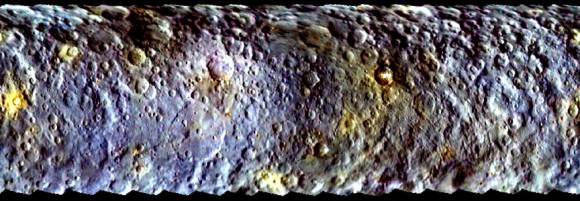
Dawn’s gravity spiral continues throughout the summer and fall until the probe tiptoes down to just 233 miles (375 km) altitude in late November. From there it will deploy its Gamma Ray and Neutron Detector (GRaND) to map the elements composing Ceres’ surface rocks. We’re in for a great ride!
Simulated Ceres rotation by Tom Ruen using the new color map
Meanwhile, scientists have assembled images taken by Dawn through blue, green and infrared filters to create a new color-enhanced map of the dwarf planet. The variety of landforms in conjunction with the color variations hint that Ceres was once an active body or one with the means to resurface itself from within. Mechanisms might involve internal heating and / or movement of water or ice.
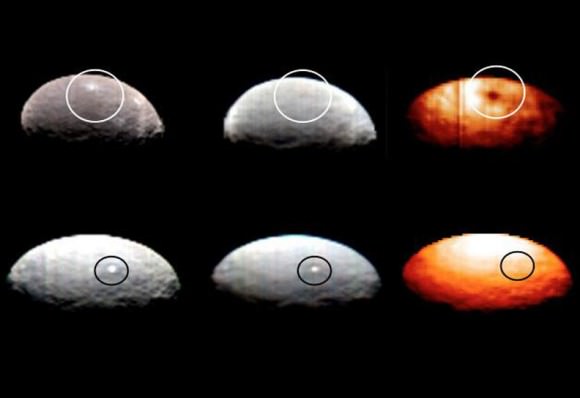
There are still no new close-ups of the pair of enigmatic white spots taunting us from inside that 57-mile-wide crater. But there is a bit of news. Dawn’s visible and infrared mapping spectrometer or VIR has already examined Ceres in visible and infrared or thermal light. Data from VIR indicate that light and darker regions on the dwarf planet have different properties.
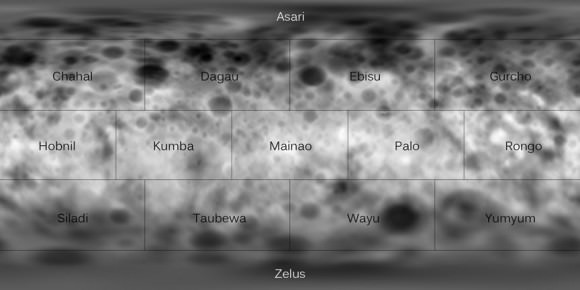
The bright spots are located in a region with a temperature similar to its surroundings. However, a different bright feature appears in a region that’s cooler than the neighboring surface. Exactly what those variations are telling us will hopefully become clear once Dawn returns more detailed images:
“The bright spots continue to fascinate the science team, but we will have to wait until we get closer and are able to resolve them before we can determine their source,” said Chris Russell, principal investigator for the Dawn mission.
Weekly Space Hangout – April 10, 2015: Orbital Docking with Dr. Stephen Granade
Host: Fraser Cain (@fcain)
Special Guest: Dr. Stephen Granade (@sargent)
Guests:
Dave Dickinson (@astroguyz / www.astroguyz.com)
Charles Black (@charlesblack / sen.com/charles-black)
Continue reading “Weekly Space Hangout – April 10, 2015: Orbital Docking with Dr. Stephen Granade”
Weekly Space Hangout – April 3, 2015: Lunar Eclipses & Asteroid Chunks!
Host: Fraser Cain (@fcain)
Guests:
Morgan Rehnberg (cosmicchatter.org / @MorganRehnberg )
Dave Dickinson (@astroguyz / www.astroguyz.com)
Continue reading “Weekly Space Hangout – April 3, 2015: Lunar Eclipses & Asteroid Chunks!”
How Dense is the Asteroid Belt?
We’ve seen way too many science fiction episodes that show asteroid belts as dense fields of tumbling boulders. How dense is the asteroid belt, and how to spacecraft survive getting through them?
For the purposes of revenue, lazy storytelling, and whatever it is Zak Snyder tells himself to get out of bed in the morning, when it comes to asteroids, Science fiction and video games creators have done something of disservice to your perception of reality.
Take a fond trip down sci-fi memory lane, and think about the time someone, possibly you, has had to dogfight or navigate through yet another frakkin’ asteroid belt. Huge space rocks tumbling dangerously in space! Action! Adventure! Only the skilled pilot, with her trusty astromecha-doplis ship can maneuver through the dense cluster of space boulders, dodging this way and that, avoiding certain collision.
And then she shoots her pew pew laser breaking up larger asteroids up into smaller ones, possibly obliterating them entirely depending on the cg budget. Inevitably, there’s bobbing and weaving. Pursuit craft will clip their wings on asteroids, spinning off into nearby tango. Some will fly straight into a space boulder.
Finally you’ll thread the needle on a pair of asteroids and the last ship of the whatever they’re called clicky clacky mantis Zorak bug people will try and catch you, but he/it won’t be quite so lucky. Poetically getting squashed like… a… bug. Sackhoff for the win, pilot victorious.
Okay, you probably knew the laser part is totally fake. I mean, everybody knows you can’t hear sounds in space. Outside of Starbuck being awesome, is that at all realistic? And if so, how does NASA maneuver unmanned spacecraft through that boulder-strewn grand canyon death trap to reach the outer planets?
The asteroid belt is a vast region between the orbits of Mars and Jupiter. Our collection of space rocks starts around 300 million kilometers from the Sun and ends around 500 million kilometers. The first asteroid, the dwarf planet Ceres which measures 950 km across, was discovered in 1801, with a “That’s funny.”. Soon after astronomers turned up many more small objects orbiting in this region at the “Oooh neat!” stage.
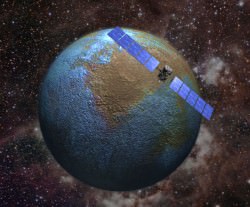
They realized it was a vast belt of material orbiting the Sun, with I suspect a “We’re all gonna die.”. To date, almost half a million asteroids have been discovered, most of which are in the main belt.
As mentioned in a another video, gathering up all the material in the asteroid belt and gluing it together makes a mass around 4% of the Moon. So, in case one of your friends gets excited and suggests it was a failed planet, you can bust out that stat and publicly shame them for being so 1996, Goodwill Hunting style. You like asteroids? How about them asteroids?
There’s a few hundred larger than 100 km across, and tens of millions of rocks a hundred meters across. Any one of these could ruin a good day, or bring a bad day to a welcome firey close for either a depressed wayfaring spacecraft or a little bluegreen speck of a planet. Which sounds dangerous all the way around.
Fortunately, our asteroid belt is a vast region of space. Let’s wind up the perspective-o-meter. If you divide the total number of objects in the field by the volume of space that asteroid belt takes up, each space rock is separated by hundreds of thousands of kilometers. Think of it as gravity’s remarkably spacious zen rock garden.
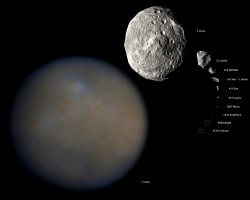
As a result, when NASA engineers plot a spacecraft’s route through the asteroid belt, they don’t expect to make a close encounter with any asteroids – in fact, they’ll change its flight path to intercept asteroids en route. Because hey look, asteroid!
Even though Ceres was discovered in 1801, it’s never been observed up close, until now. NASA’s Dawn spacecraft already visited Asteroid Vesta, and by the time you’re watching this video, it will have captured close-up images of the surface of Ceres.
Once again, science fiction creatives sold us out to drama over hard science. If you’re passing through an asteroid belt, you won’t need to dodge and weave to avoid the space rocks. In fact, you probably wouldn’t even know you were passing through a belt at all. You’d have to go way the heck over there to even get a nearby look at one of the bloody things. So we’re safe, our speck is safe, and all the little spacecraft are safe…. for now.
Which dramatic version of “asteroids” are you most fond of? Tell us in the comments below.
Weekly Space Hangout – March 20, 2015: Lee Billings’ Five Billion Years of Solitude
Host: Fraser Cain (@fcain)
Special Guest: Author Lee Billings, discussing his book “Five Billion Years of Solitude”(@LeeBillings / leebillings.com/)
Guests:
Dr. Pamela Gay (cosmoquest.org / @starstryder)
Morgan Rehnberg (cosmicchatter.org / @MorganRehnberg )
Brian Koberlein (@briankoberlein)
Continue reading “Weekly Space Hangout – March 20, 2015: Lee Billings’ Five Billion Years of Solitude”
Weekly Space Hangout -March 13, 2015: Astrophysicist Katie Mack
Host: Fraser Cain (@fcain)
Special Guest: Astrophysicist Katie Mack (@AstroKatie)
Guests:
Ramin Skibba (@raminskibba)
Charles Black (@charlesblack / sen.com/charles-black)
Brian Koberlein (@briankoberlein)
Continue reading “Weekly Space Hangout -March 13, 2015: Astrophysicist Katie Mack”
Scientists in Orbit Over Dawn’s Arrival at Ceres
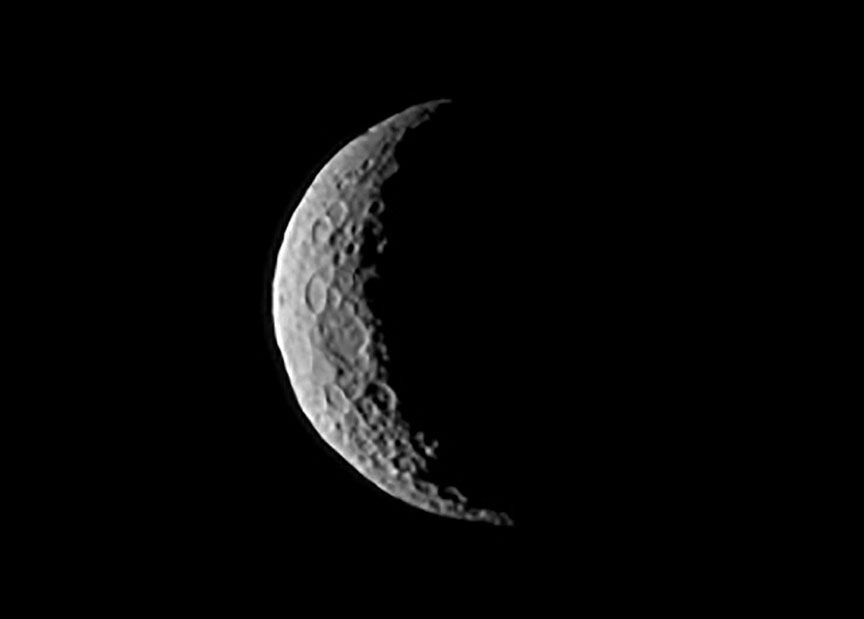
Dawn’s approach and trajectory as it begins its orbital “dance” with Ceres. As you watch, note the timeline at upper right.
Dawn made it! After a 14-month tour of the asteroid Vesta and 2 1/2 years en route to Ceres, the spacecraft felt the gentle tug of Ceres gravity and slipped into orbit around the dwarf planet at 6:39 a.m. (CST) Friday morning.
“We feel exhilarated,” said lead researcher Chris Russell at the University of California, Los Angeles, after Dawn radioed back the good news.
Not only is this humankind’s first probe to orbit a dwarf planet, Dawn is the only spacecraft to fly missions to two different planetary bodies. Dawn’s initial orbit places it 38,000 miles (61,000 km) from Ceres with a view of the opposite side of Ceres from the Sun. That’s why we’ll be seeing photos of the dwarf planet as a crescent for the time being. If you watch the video, you’ll notice that Dawn won’t see Ceres’ fully sunlit hemisphere until early-mid April.
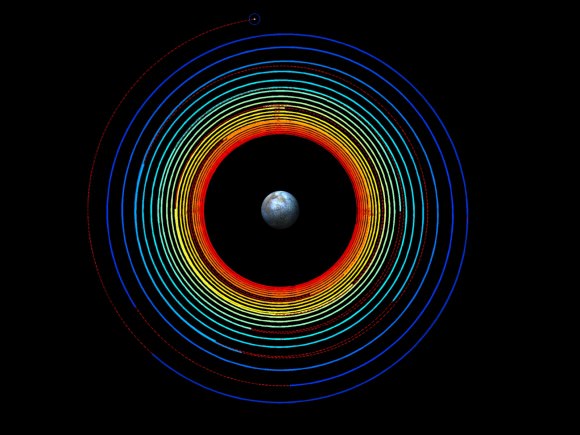
The spacecraft will spend the next month gradually spiraling down to Ceres to reach its “survey orbit” of 2,730 miles in April. From there it will train its science camera and visible and infrared mapping spectrometer to gather pictures and data. The leisurely pace of the orbit will allow Dawn to spend more than 37 hours examining Ceres’ dayside per revolution. NASA will continue to lower the spacecraft throughout the year until it reaches its minimum altitude of 235 miles.
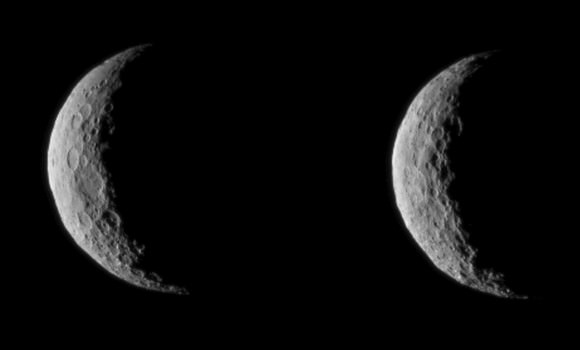
“Since its discovery in 1801, Ceres was known as a planet, then an asteroid and later a dwarf planet,” said Marc Rayman, Dawn chief engineer and mission director at JPL. “Now, after a journey of 3.1 billion miles (4.9 billion kilometers) and 7.5 years, Dawn calls Ceres, home.”
More about Dawn’s incredible accomplishment can be found in the excellent Dawn Journal, written by Dawn chief engineer and mission director Marc Rayman.
What Your Breakfast has in Common with Ceres
On March 6, the Dawn spacecraft will ease into orbit around the dwarf planet Ceres. This is the visit to a dwarf planet (New Horizons will flyby Pluto later this year) and scientists are eager to see its surface in detail. But did you know that Ceres got its name from the ancient Roman goddess of agriculture and grain crops? Think about that when you enjoy your breakfast!
As we mentioned in our previous article about the intriguing white spots that Dawn has seen on Ceres as it makes its approach, Dawn will then continue to spiral its way down to an altitude of about 920 miles (1,480 kilometers), and in August 2015 will begin a two-month phase known as the high-altitude mapping orbit. Then, it will spiral down to an altitude of about 2,750 miles (4,430 kilometers), and obtain more science data in its survey science orbit. This phase will last for 22 days, and is designed to obtain a global view of Ceres with Dawn’s framing camera, and global maps with the visible and infrared mapping spectrometer (VIR).
Dawn will then continue to spiral its way down to an altitude of about 920 miles (1,480 kilometers), and in August 2015 will begin a two-month phase known as the high-altitude mapping orbit. During this phase, the spacecraft will continue to acquire near-global maps with the VIR and framing camera at higher resolution than in the survey phase. The spacecraft will also image in “stereo” to resolve the surface in 3-D.
Then, after spiraling down for two months, Dawn will begin its closest orbit around Ceres in late November, at a distance of about 233 miles (375 kilometers). The dance at low-altitude mapping orbit will be a long waltz — three months — and is specifically designed to acquire data with Dawn’s gamma ray and neutron detector (GRaND) and gravity investigation. GRaND will reveal the signatures of the elements on and near the surface. The gravity experiment will measure the tug of the dwarf planet, as monitored by changes in the high-precision radio link to NASA’s Deep Space Network on Earth.
Dawn’s nominal mission to Ceres is expected to last for 16 months.
Find out more about the mission at the Dawn website.



